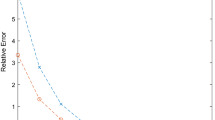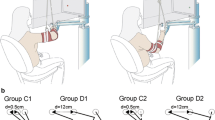Abstract
We propose and simulate a new paradigm for organization of motor control in fast and accurate human arm motions. We call the paradigm “direct motor program learning” since the control programs are learned directly without knowing or learning the dynamics of a controlled system.
The idea is to approximate the dependence of the motor control programs on the vector of the task parameters rather than to use a model of the system dynamics. We apply iterative learning control and scattered data multivariate approximation techniques to achieve the goal. The advantage of the paradigm is that the control complexity depends neither on the order nor on the nonlinearity of the system dynamics.
We simulate the direct motor program learning paradigm in the task of point-to-point control of fast planar human arm motions. Simulation takes into account nonlinear arm dynamics, muscle force dynamics, delay in low-level reflex feedback, time dependence of the feedback gains and coactivation of antagonist muscles. Despite highly nonlinear time-variant dynamics of the controlled system, reasonably good motion precision is obtained over a wide range of the task parameters (initial and final positions of the arm). The simulation results demonstrate that the paradigm is indeed viable and could be considered as a possible explanation for the organization of motor control of fast motions.
Similar content being viewed by others
References
Adamovitch SB, Berkenblit MB, Feldman AG (1990) Principles of human motor control, part I (in Russian). Itogi Nauki i Tech niki, Ser Fiziologija Cheloveka i Zhivotnykh, Tom 43. VINITI, Moscow
Arimoto S (1990) Learning control theory for robotic motion. Int J Adaptive Control Signal Processing 4:543–564
Arimoto S, Kawamura S, Miyazaki F (1984) Bettering operation of robots by learning. J Robotic Syst 1:123–140
Atkeson CG (1991) Using locally weighted regression for robot learning. In: Proceedings of the 1991 IEEE International Conference on Robotics and Automation, Sacramento, Calif, p 963
Bernstein NA (1947) On composition of motions (in Russian). Medgiz, Moscow
Craig JJ (1986) Introduction to robotics. Addison-Wesley, Reading, Mass
Dornay M et al. (1991) Simulation of optimal movements using the minimum-muscle-tension-change model. In: Lipmann RP, Moody JE and Touretzky DS (eds) Advances in Neural Information Processing Systems 3. Morgan Kaufmann, San Mateo, CA, vol 3, pp 627–634
Farwig R (1987) Multivariable interpolation of arbitrary spaced data by moving least squares methods. J Comp Applied Math 16:79–93
Feldman A (1979) Central and reflex mechanisms of motor control (in Russian). Nauka, Moscow
Flash T, Hogan N (1985) The coordination of arm movements: an experimentally confirmed mathematical model. J Neurosci 5:1688–1703
Foley TA (1986) Scattered data interpolation and approximation with error bounds. Comp Aided Geom Design 3:163–177
Franke R (1986) Recent advances in the approximation of surfaces from scattered data. In: Chui CK et al. (ed) Topics in multivariable approximation. Academic Press, Boston, pp 79–98
Goodwin GC, Sin KS (1984) Adaptive filtering, prediction and control. Prentice-Hall, Englewood Cliffs, NJ
Gorinevsky DM (1991) Learning and approximation in database for feed-forward control of flexible-joint manipulator. In: Proc '91 ICAR: 5th International Conf on Advanced Robotics, Pisa, pp 688–692
Gorinevsky DM (1992a) Experiments in direct learning of feedforward control for manipulator trajectory tracking. Robotersysteme 8:139–147
Gorinevsky DM (1992b) On the approximate inversion of linear system and quadratic-optimal control. Sov J Comp Syst Sci (in press)
Gorinevsky DM, Connolly TH (1992) Comparison of artificial neural network and scattered data approximations: the inverse manipulator kinematics example. Technical Report. Lehrstuhl B für Mechanik, TU-München, August 1992 (also submitted to Neural Computation)
Guez A, Selinsky J (1988) a trainable neuromorphic controller. J Robotic Syst 5:363–388
Kano H, Takayama K (1990) Learning control of robotic manipulator based on neurological model CMAC. In: 11th IFAC Congress, Tallinn, pp 268–273
Katayama M, Kawato M (1991) Learning trajectory and force control of an artificial muscle arm by parallel-hierarchical neural network model. Advances in Neural Information Processing Systems 3. Morgan Kaufmann, San Mateo, CA, vol 3, pp 436–442
Kawato M (1989) Adaptation and learning in control of voluntary movement by the central nervous system (tutorial). Adv Robotics 3:229–249
McLain DH (1976) Two dimensional interpolation from random data. Comput J 19:178–181
Messner W, Horowitz R, Kao WW, Boals M (1991) A new adaptive learning rule. IEEE Trans Automat Contr 36:188–197
Morgan DL (1990) New insights into the behavior of muscle during active lengthening. Biophys J 37:209–221
Oh SR, Bien Z, Suh IH (1988) An iterative learning control method with application for the robot manipulator. IEEE J Robotics Automation 4:508–514
Renka RJ (1988) Multivariable interpolation of large sets of scattered data. ACM Trans Math Software 14:139–148
Sanchez VDA, Hirzinger G (1991) State-of-the-art robotic learning control based on artificial neural networks. An overview. In: Khatib O et al. (ed) The robotic review 2. MIT Press, Cambridge, Mass
Sondern JF van, Denier van der Gon JJ (1990) A simulation study of a programme generator for centrally programmed fast two-joint arm movement: responses to single- and double-step target displacements. Biol Cybern 63:35–44
Togai M, Yamano O (1986) Learning control and its optimality. In: Proceedings of the 1986 IEEE Conference on Robotics and Automation, San Francisco, Calif, pp 248–253
Tikhonov AN, Arsenin VYa (1979) Methods for solution of ill-posed problems (in Russian). Nauka, Moscow
Uno Y, Suzuki R, Kawato M (1989) Formation and control of optimal trajectory in human multijoint arm movement — minimum torque change model. Biol Cybern 61:89–101
Wu CH, Young KY, Hwang KS, Leman S (1992) Voluntary movements for robotic control. IEEE Contr Syst Magazine 12:8–14
Yabuta T, Yamada T (1990) Possibility of neural network controller or robot manipulators. Proceeding of the 1990 IEEE International Conference on Robotics and Automation, Cincinnati, Ohio, pp 1686–1691
Zahalak GI, Pramod R (1985) Myoelectric response of the human triceps brachii to displacement-controlled oscillations of the forearm. Exp Brain Res 58:305–317
Author information
Authors and Affiliations
Rights and permissions
About this article
Cite this article
Gorinevsky, D.M. Modelling of direct motor program learning in fast human arm motions. Biol. Cybern. 69, 219–228 (1993). https://doi.org/10.1007/BF00198962
Received:
Accepted:
Issue Date:
DOI: https://doi.org/10.1007/BF00198962




